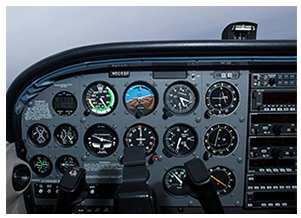Training Tips
|

A mix of messages
"Watch that altitude! What's your heading?" Rare is the student pilot who hasn't let distraction, or turbulence, spoil a slick stint of steady flying. Then you vow to do a better job next time of keeping track of the messages your instruments are displaying.
Not all instrument indications should be taken at face value, however. (And when keeping track of one key flight parameter, there usually is no instrument available at all!)
You have learned that the art of monitoring your trainer's flight condition requires that you glean the indications displayed by numerous needles, numbers, "bugs," and colored arcs, and then interpret what you see based on each instrument's unique manner of communication.
The altimeter properly set to atmospheric pressure (or field elevation) provides a direct indication of your altitude—no interpretation needed. A directional gyro set within the last few minutes against a steady magnetic compass should be accurate (if you haven't been flying aggressive or steep maneuvers).
Some instruments are known for their unreliability: "Placing your trust in the fuel gauge of a small general aviation airplane makes about as much sense as shooting a piano for its ivory," cautioned Rod Machado in this Flight Training article about fuel estimation. Much better technique is to use a clock and a known fuel-consumption figure to track your progress. Plan with ample reserves, and ensure that the fuel tanks contain the quantity of fuel you think they contain. (Do you always fly with full tanks on training fights?)
Some gauges in your panel scan quickly draw the eye if an abnormal reading is displayed. In certain cases, such as engine oil temperature and pressure, the indications make more sense when considered together. Low oil pressure and high oil temperature spell engine trouble.
What parameter is essential for pilot monitoring but unavailable on any gauge on your panel? Most general aviation aircraft still lack an angle-of-attack indicator. That may start to change, but in the meantime, the ability a pilot gains through flight training to recognize the sensations and behavior of the aircraft as its angle of attack changes is the most reliable system for early warning—or better still, avoidance—of an approach to an accidental stall.
In some aircraft, the location of an instrument may make it difficult to see. Make a special effort to include it in your scans.
|
|



